CSIR NET Plant Developmental Biology Notes
CSIR NET UNIT 5 Developmental Biology is an important unit for the CSIR NET exam, with a weightage of nearly 30+ marks in each exam, conducted twice a year. It is suggested to prepare this unit beforehand and avoid last-minute study. Important topics from this unit should not be skipped.
Some students may find it difficult to understand the concepts, so reference books like Developmental Biology by Scott F. Gilbert and Principles of Development by Lewis Wolpert and Cheryll Tickle can be helpful.
In these notes, topics related to Male and Female Gametophyte Development, Pollination, Double Fertilization, and Gamete Production have been discussed briefly, along with flowcharts and mnemonics to aid in a better understanding of the concepts.
For detailed notes with flowcharts, tables, animations, test papers, lecture videos, and PPTs, one can join the CSIR NET JEET Batch, which has pre-admissions open. Scholarships are also available. For more information, call the TOLL-FREE number 1800-1200-1818 or chat online.
Admissions open for Fast Track Revision Batch For CSIR NET June 2023 for super fast 60 days revision
CSIR NET Plant Developmental Biology Notes
Gamete Production in Angiosperms
Key Points
- Gamete production in angiosperms occurs through meiosis, which produces haploid cells.
- The male gametophyte is the pollen grain, which develops from a microspore within the microsporangium of the anther.
- Each microspore undergoes mitosis to produce two cells – the generative cell and the tube cell.
- If pollination is successful, a pollen grain produces a pollen tube that grows down into the ovary and discharges two sperm cells near the embryo sac.
- The sperm cells then fertilize the egg cell and the central cell of the embryo sac, leading to the formation of a zygote and endosperm, respectively.
- The female gametophyte is the embryo sac, which develops within the ovule, a structure within the ovary that contains the female reproductive cells.
- Within the ovule, a megasporangium undergoes meiosis to produce four haploid megaspores, only one of which survives.
- The surviving megaspore undergoes mitosis to produce a large cell with eight haploid nuclei, which is partitioned into a multicellular female gametophyte, the embryo sac.
- The two polar nuclei in the central cell of the embryo sac will fuse with one of the sperm nuclei to produce the endosperm, which will nourish the developing embryo.
Quick Concept Recall Flowchart:
Meiosis → Haploid cells → Pollen grain (male gametophyte) → Generative cell + tube cell → Pollination → Pollen tube → Sperm cells → Fertilization → Zygote + endosperm → Embryo sac (female gametophyte) → Megaspore → Mitosis → Haploid cells → Embryo sac → Fertilization → Endosperm.
Haplodiplontic life cycles
- Haplodiplontic life cycles involve the alternation between haploid (n) and diploid (2n) multicellular stages.
- The haploid stage is called the gametophyte, while the diploid stage is called the sporophyte.
- In haplodiplontic life cycles, the sporophyte produces spores through meiosis.
- Spores develop into gametophytes, which produce gametes (sperm and eggs) through mitosis.
- Fertilization of the egg by the sperm produces a diploid zygote, which develops into a new sporophyte.
- In angiosperms, the sporophyte is the dominant generation, while the gametophytes are reduced in size and depend on the sporophyte for nutrients.
- The haploid stage of the life cycle is important for genetic variation, as it allows for the formation of new combinations of genetic traits.
Quick Concept Recall Flowchart:
Sporophyte (2n) → Meiosis → Spores (n) → Gametophyte (n) → Mitosis → Gametes (n) → Fertilization → Zygote (2n) → Sporophyte (2n) → Meiosis → Spores (n) → Gametophyte (n) → Mitosis → Gametes (n) → Fertilization → Zygote (2n)…
Tips to remember this topic: Haplodiplontic life cycles
- Understand the terms “gametophyte” and “sporophyte” and their ploidy level (n or 2n).
- Remember that spores are produced through meiosis, while gametes are produced through mitosis.
- Visualize the flowchart and practice tracing the cycle from the sporophyte to the gametophyte and back to the sporophyte again.
- Try to relate the process to examples of plants you are familiar with, such as ferns or flowering plants.
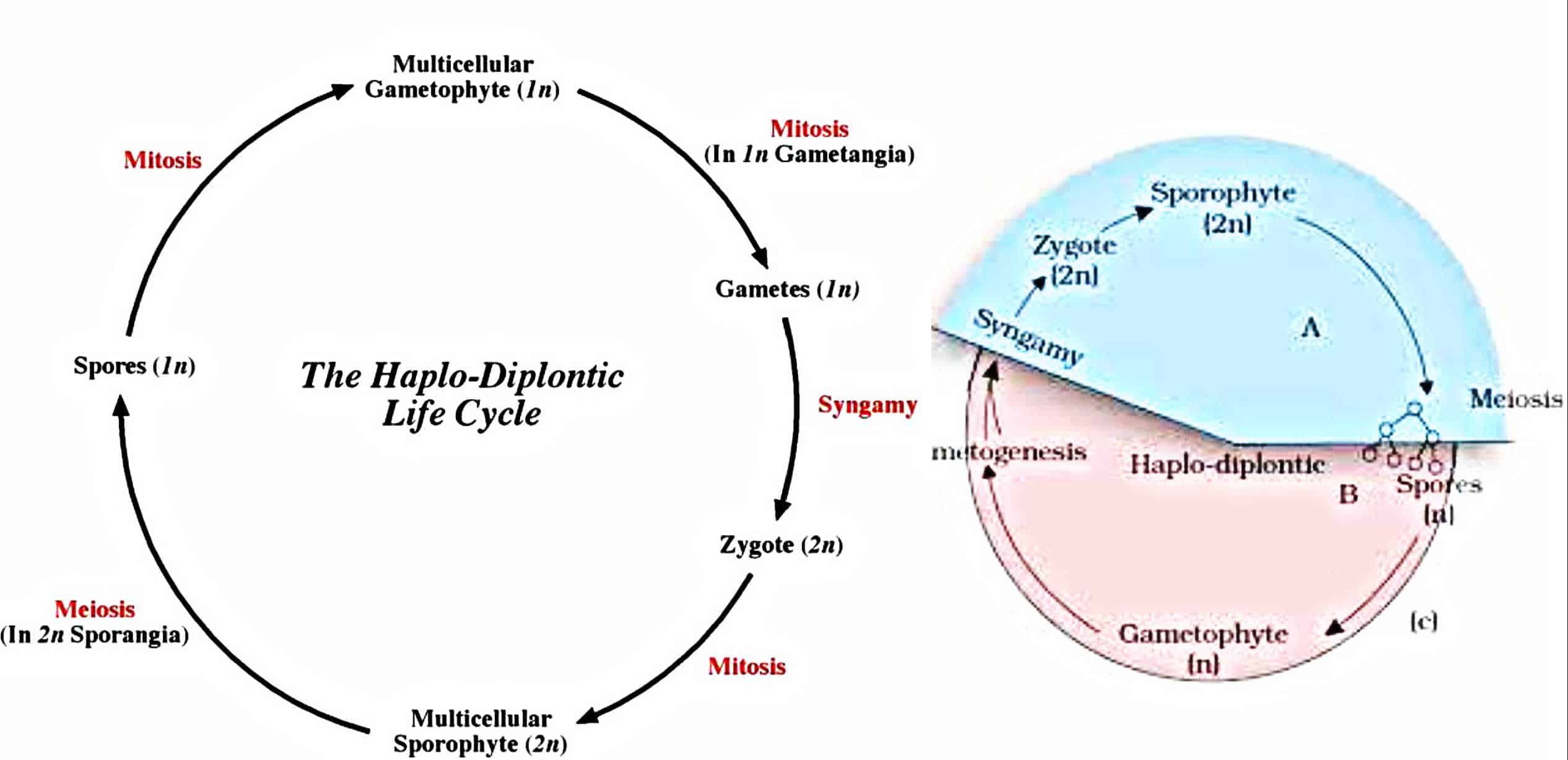
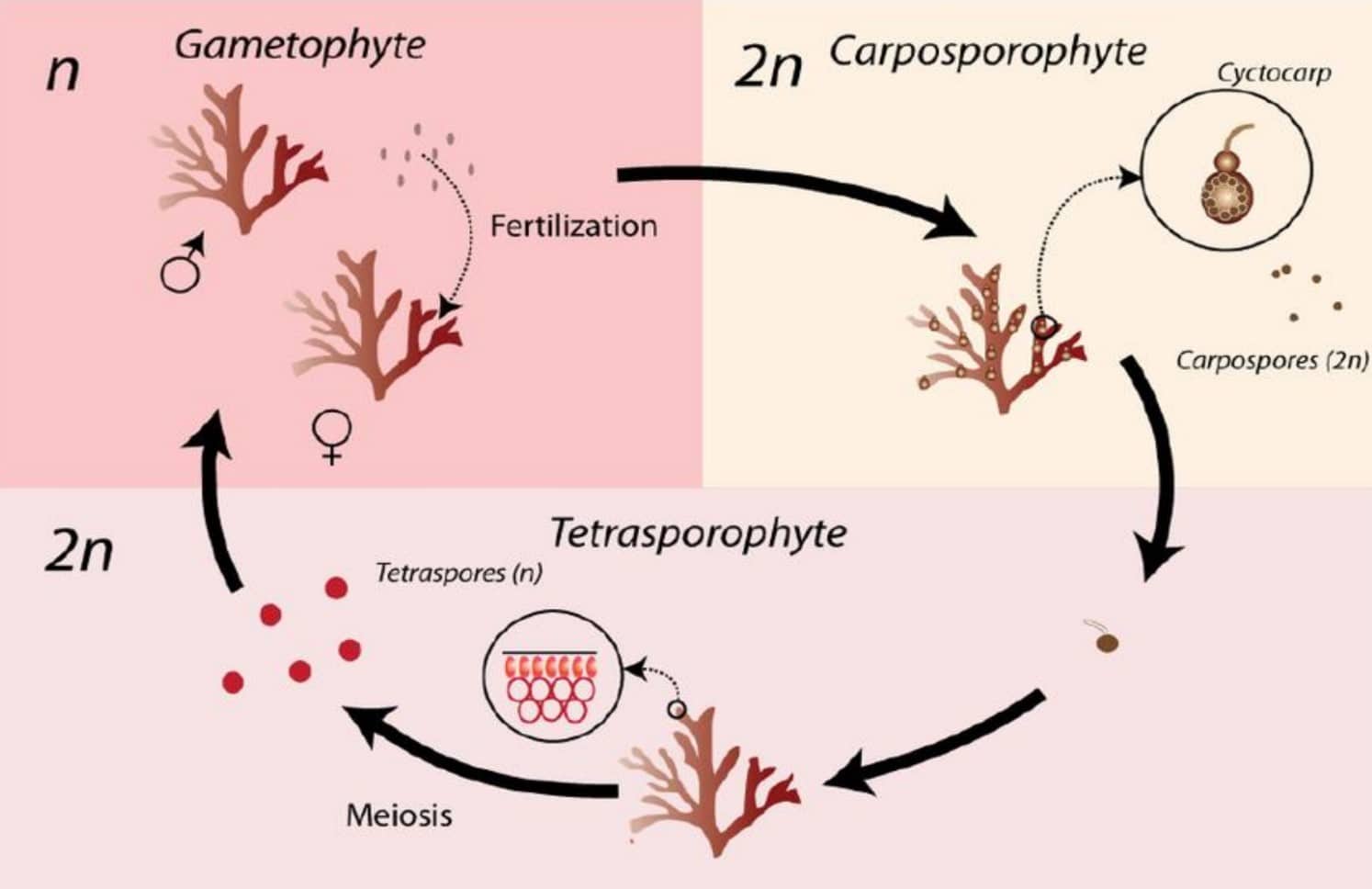
CSIR NET Plant Developmental Biology Notes
Male Gametophyte Development:
- Male gametophyte development, also known as pollen development, is the process by which a mature pollen grain is produced from a diploid microspore cell. Here are some important points to remember:
- The process of male gametophyte development begins with the division of a diploid microspore cell located in the anther of the flower.
- The microspore undergoes meiosis, resulting in the formation of four haploid microspores.
- Each microspore undergoes mitosis, resulting in the formation of two haploid cells, a generative cell and a tube cell.
- The generative cell divides once more, producing two haploid sperm cells.
- The tube cell and the generative cell are surrounded by a protective wall, forming a mature pollen grain.
- Once the pollen grain is mature, it is released from the anther and carried by wind or insects to the female part of the flower for fertilization.
Here is a flowchart to help you visualize the process:
Diploid microspore cell –> Meiosis –> Four haploid microspores –> Mitosis –> Generative cell and tube cell –> Generative cell division –> Two haploid sperm cells –> Protective wall formation –> Mature pollen grain –> Fertilization
Mnemonic To Understand Male Gametophyte Development: you could remember the order of events with the acronym “DM-FHM-GCT-GCD-TPM-F” (Diploid microspore, Four haploid microspores, Generative cell and tube cell, Generative cell division, Two haploid sperm cells, Protective wall formation, Mature pollen grain, Fertilization).
Pollen Grains
- Consist of an outer wall exine and an inner wall intine
- A pollen grain consists of a cell within a cell.
- The generative cell will undergo division to produce two sperm cells.
- One will fertilize the egg, and the other will join with the polar nuclei, yielding the endosperm.
Female Gametophyte Development: Embryo Sac Formation and Egg Development
Female gametophyte development, also known as embryo sac development, is the process by which a mature female gametophyte, or embryo sac, is produced from a diploid megaspore cell. Here are some important points to remember:
- The process of female gametophyte development begins with the division of a diploid megaspore cell located in the ovule of the flower.
- The megaspore undergoes mitosis, resulting in the formation of a multicellular structure called the female gametophyte or embryo sac.
- The embryo sac contains three antipodal cells, two synergid cells, one egg cell, and a central cell with two polar nuclei.
- The synergid cells are located at the micropylar end of the embryo sac and play a role in guiding the pollen tube to the egg cell.
- The central cell is located at the chalazal end of the embryo sac and contains two polar nuclei that will eventually fuse with a sperm cell to form the endosperm.
- Once the pollen grain reaches the ovule, it forms a pollen tube that grows through the stigma and style and enters the embryo sac through the micropyle.
- The two sperm cells are released from the pollen tube and one fertilizes the egg cell, resulting in the formation of a zygote.
- The other sperm cell fuses with the two polar nuclei in the central cell, resulting in the formation of a triploid endosperm.
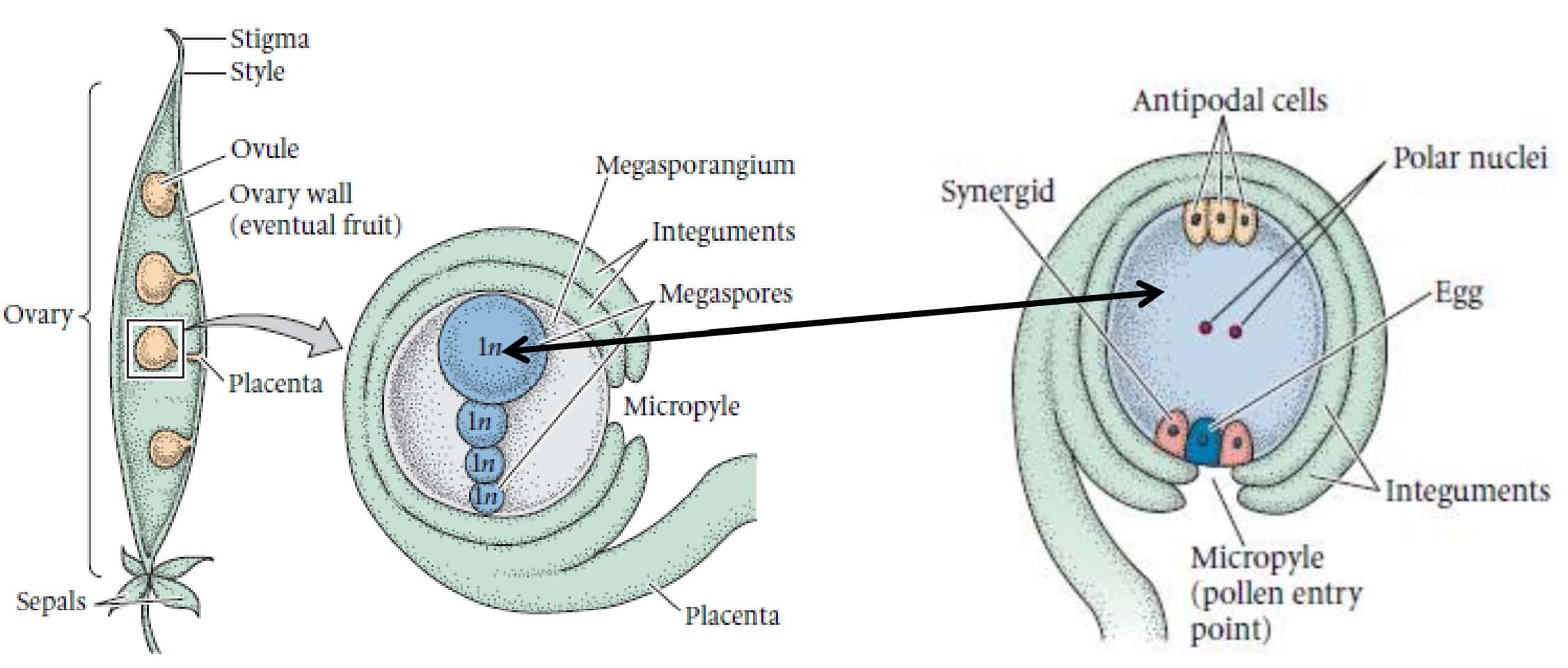
Here is a flowchart to help you visualize & remeber the Female gametophyte Development process:
Diploid megaspore cell –> Mitosis –> Female gametophyte/Embryo sac –> Antipodal cells, synergid cells, egg cell, and central cell with polar nuclei –> Pollen tube growth –> Fertilization of egg cell –> Zygote formation –> Fusion of sperm cell with polar nuclei –> Endosperm formation

mnemonic: remember the order of events with the acronym “DM-FGM-AS-SE-EC-CC-PG-FZ-SP-EN” (Diploid megaspore cell, Female gametophyte/Embryo sac, Antipodal cells, Synergid cells, Egg cell, Central cell with polar nuclei, Pollen tube growth, Fertilization of egg cell, Zygote formation, Fusion of sperm cell with polar nuclei, Endosperm formation).
Types of embryo sacs are as follows:
- Monosporic: In monosporic embryo sacs, only one of the four megaspores produced by meiosis survives and undergoes mitosis to form the mature embryo sac. This type of embryo sac is found in most angiosperms, including wheat, rice, and Arabidopsis. Monosporic embryo sacs can be further classified into two types based on the number of nuclei present:
- Polygonum type: In the Polygonum type of embryo sac, the nucleus divides several times without forming cell walls, resulting in a multinucleate cytoplasm. This type of embryo sac is found in many plants, including tobacco and sunflower.
- Allium type: In the Allium type of embryo sac, the nucleus undergoes three rounds of mitosis with cell wall formation, resulting in eight haploid nuclei that are distributed among seven cells. This type of embryo sac is found in some plants, including onion and garlic.
- Bisporic: In bisporic embryo sacs, two of the four megaspores produced by meiosis survive and develop into the mature embryo sac. This type of embryo sac is found in some flowering plants, including some species of orchids.
- Tetrasporic: In tetrasporic embryo sacs, all four megaspores produced by meiosis survive and develop into the mature embryo sac. This type of embryo sac is found in some flowering plants, including some species of grasses and sedges.
CSIR NET Plant Developmental Biology Notes
Pollination: Interaction between Pollen and Stigma
Pollination is the process by which pollen grains are transferred from the anther of a flower to the stigma of the same or a different flower, leading to fertilization and the production of seeds. Here are some important points to remember:
- Pollination can occur through different agents, including wind, water, and animals, such as bees, butterflies, birds, and bats.
- Pollination can be classified into two main types based on the agent involved:
- Abiotic pollination: This type of pollination occurs through non-living agents, such as wind and water. Wind-pollinated flowers are usually small, inconspicuous, and produce large amounts of lightweight pollen. Water-pollinated flowers are usually found in aquatic plants and release their pollen directly into the water.
- Biotic pollination: This type of pollination occurs through living agents, such as insects, birds, and mammals. Biotic-pollinated flowers are usually larger, more colorful, and produce sticky or spiky pollen that can attach to the body of the pollinator.
- The process of pollination involves several steps, including the following:
- Pollen grain is produced by the anther of the flower.
- Pollen grain is transferred to the stigma of the same or a different flower.
- Pollen grain germinates on the stigma, producing a pollen tube that grows through the style and reaches the ovule.
- Sperm cells are released from the pollen tube and fertilize the egg cell and the polar nuclei in the embryo sac, leading to the formation of a zygote and an endosperm.
Here is a flowchart to help you visualize the process:
Anther –> Pollen grain production –> Transfer to stigma –> Pollen grain germination –> Pollen tube growth –> Fertilization –> Zygote and endosperm formation
To remember these concepts, it is helpful to break them down into smaller parts and study each part separately. It is also helpful to use mnemonic devices, such as acronyms or rhymes, to remember important steps in the process. For example, you could remember the order of events with the acronym “APP-TPG-FZE” (Anther, Pollen grain production, Transfer to stigma, Pollen grain germination, Pollen tube growth, Fertilization, Zygote and endosperm formation).
Double Fertilization
Double fertilization is a unique process that occurs during the sexual reproduction of flowering plants, in which two sperm cells from a pollen grain fertilize two cells within the female gametophyte, forming both a zygote and an endosperm. Here are some important points to remember:
- Double fertilization begins with the growth of a pollen tube from the pollen grain, which extends through the style and reaches the ovary of the flower.
- The pollen tube enters the ovule through a small opening called the micropyle and grows towards the embryo sac.
- Once the pollen tube reaches the embryo sac, it releases two sperm cells.
- One sperm cell fertilizes the egg cell, resulting in the formation of a zygote, which develops into an embryo.
- The other sperm cell fuses with the two polar nuclei in the central cell of the female gametophyte, resulting in the formation of a triploid endosperm.
- The endosperm serves as a source of nutrients for the developing embryo and the seedling.
Here is a flowchart to visualize the process of Double Fertilization:
Pollen grain –> Pollen tube growth –> Entrance through micropyle –> Release of two sperm cells –> Fertilization of egg cell –> Zygote formation –> Fusion of sperm cell with polar nuclei –> Endosperm formation
Mnemonic To remember these concepts: Remember the order of events with the acronym “PG-PT-ME-RS-FZ-EF” (Pollen grain, Pollen tube growth, Micropyle entrance, Release of two sperm cells, Fertilization of egg cell, Zygote formation, Endosperm formation).
CSIR NET Plant Developmental Biology Notes
Embryogenesis
Plant embryogenesis is the process by which a mature embryo is formed from the fertilized egg cell in a plant. Here are some important points to remember:
- Embryogenesis begins with the fusion of the sperm cell and egg cell during double fertilization, resulting in the formation of a zygote.
- The zygote undergoes a series of mitotic divisions to form an embryo.
- During embryogenesis, the embryo undergoes three distinct stages: the globular stage, the heart stage, and the torpedo stage.
- During the globular stage, the embryo is roughly spherical in shape and has a few visible cells.
- During the heart stage, the embryo elongates and acquires a heart-shaped appearance.
- During the torpedo stage, the embryo continues to elongate and acquires a more elongated, torpedo-shaped appearance.
- As the embryo develops, it differentiates into different cell types and structures, including the cotyledons, hypocotyl, and radicle.
- The mature embryo is surrounded by a protective seed coat and contains the endosperm, which provides nutrients for the developing embryo.
Here is a flowchart to help you visualize the process of Embryogenesis
Fertilization –> Zygote formation –> Mitotic divisions –> Globular stage –> Heart stage –> Torpedo stage –> Cell differentiation –> Formation of cotyledons, hypocotyl, and radicle –> Protective seed coat formation –> Endosperm formation
You could remember the order of events with the acronym “FZ-MD-GS-HS-TS-CD-CHR-PS-EN” (Fertilization, Zygote formation, Mitotic divisions, Globular stage, Heart stage, Torpedo stage, Cell differentiation, Cotyledon, Hypocotyl, Radicle formation, Protective seed coat formation, Endosperm formation).
For detailed notes with flowcharts, tables, animations, test papers, lecture videos, and PPTs, one can join the CSIR NET JEET Batch, which has pre-admissions open. Scholarships are also available. For more information, call the TOLL-FREE number 1800-1200-1818 or chat online.
Admissions open for Fast Track Revision Batch For CSIR NET June 2023 for super fast 60 days revision
Radial and axial patterning are two processes that occur during embryogenesis in plants, which help to establish the overall shape and organization of the developing embryo. Here are some important points to remember:
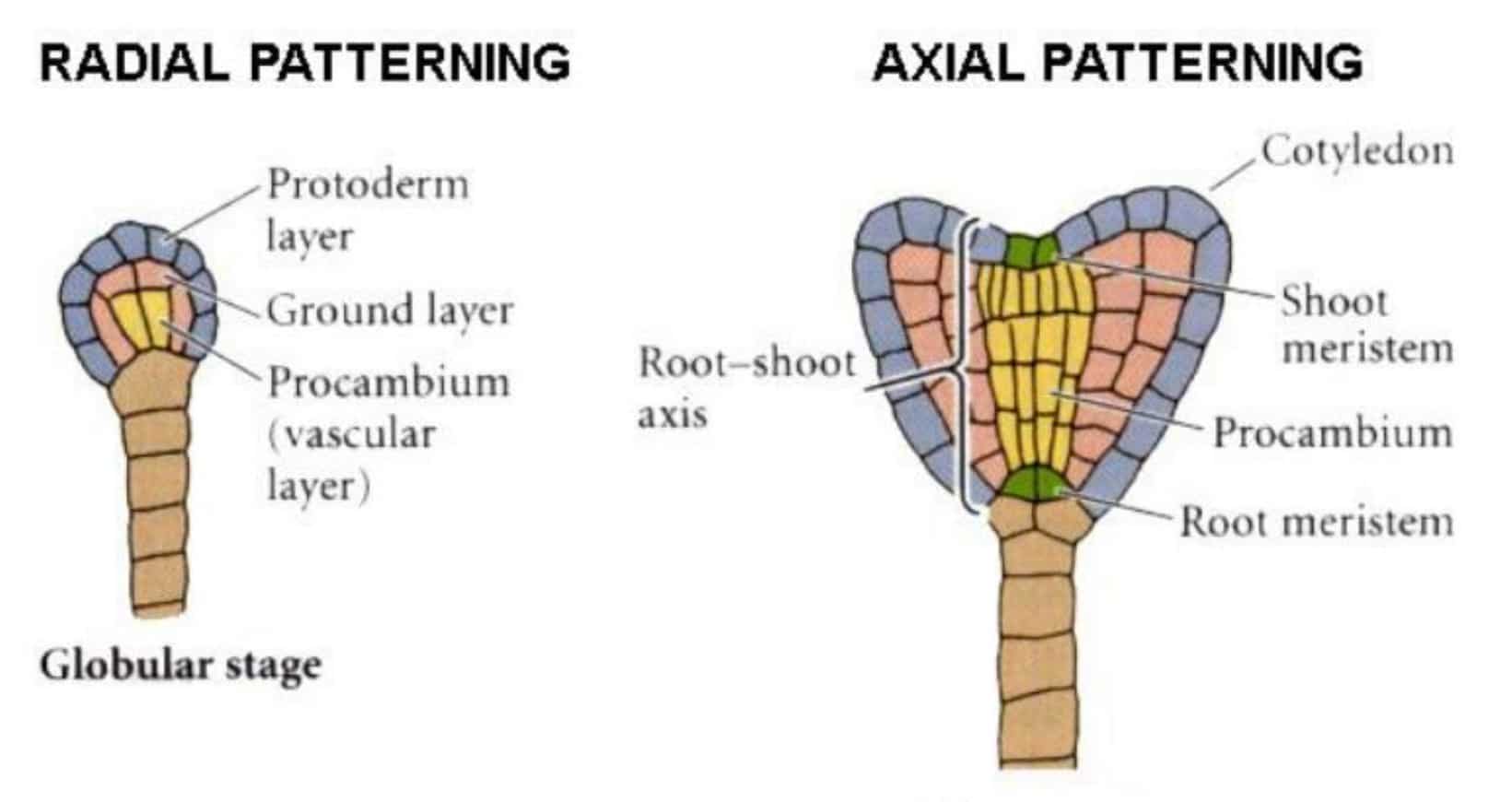
- Radial patterning refers to the organization of cells along the radial axis of the embryo, from the apical to the basal end.
- Axial patterning refers to the organization of cells along the anterior-posterior axis of the embryo, from the top to the bottom.
- Radial patterning is established early in embryogenesis, during the globular stage, and is controlled by genes that regulate the expression of transcription factors, which control cell fate and differentiation.
- Radial patterning results in the formation of different tissue layers, including the protoderm, ground meristem, and procambium, which give rise to the epidermis, ground tissue, and vascular tissue, respectively.
- Axial patterning is established later in embryogenesis, during the heart and torpedo stages, and is controlled by genes that regulate the expression of positional information molecules, such as hormones and signaling molecules.
- Axial patterning results in the formation of different structures along the anterior-posterior axis of the embryo, including the cotyledons, hypocotyl, and radicle.
- Both radial and axial patterning are critical for the proper development and function of the mature plant.
CSIR NET Plant Developmental Biology Notes




























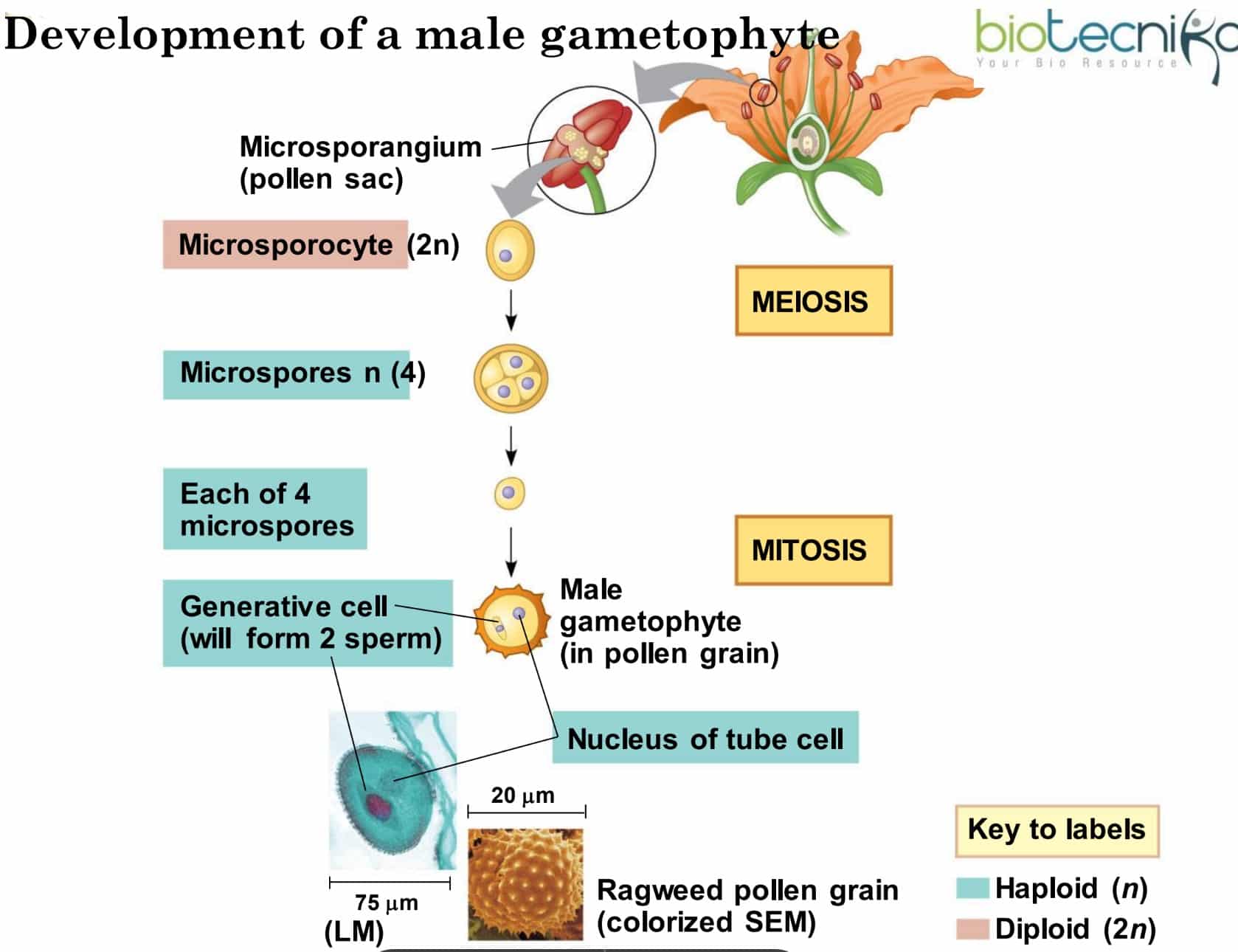
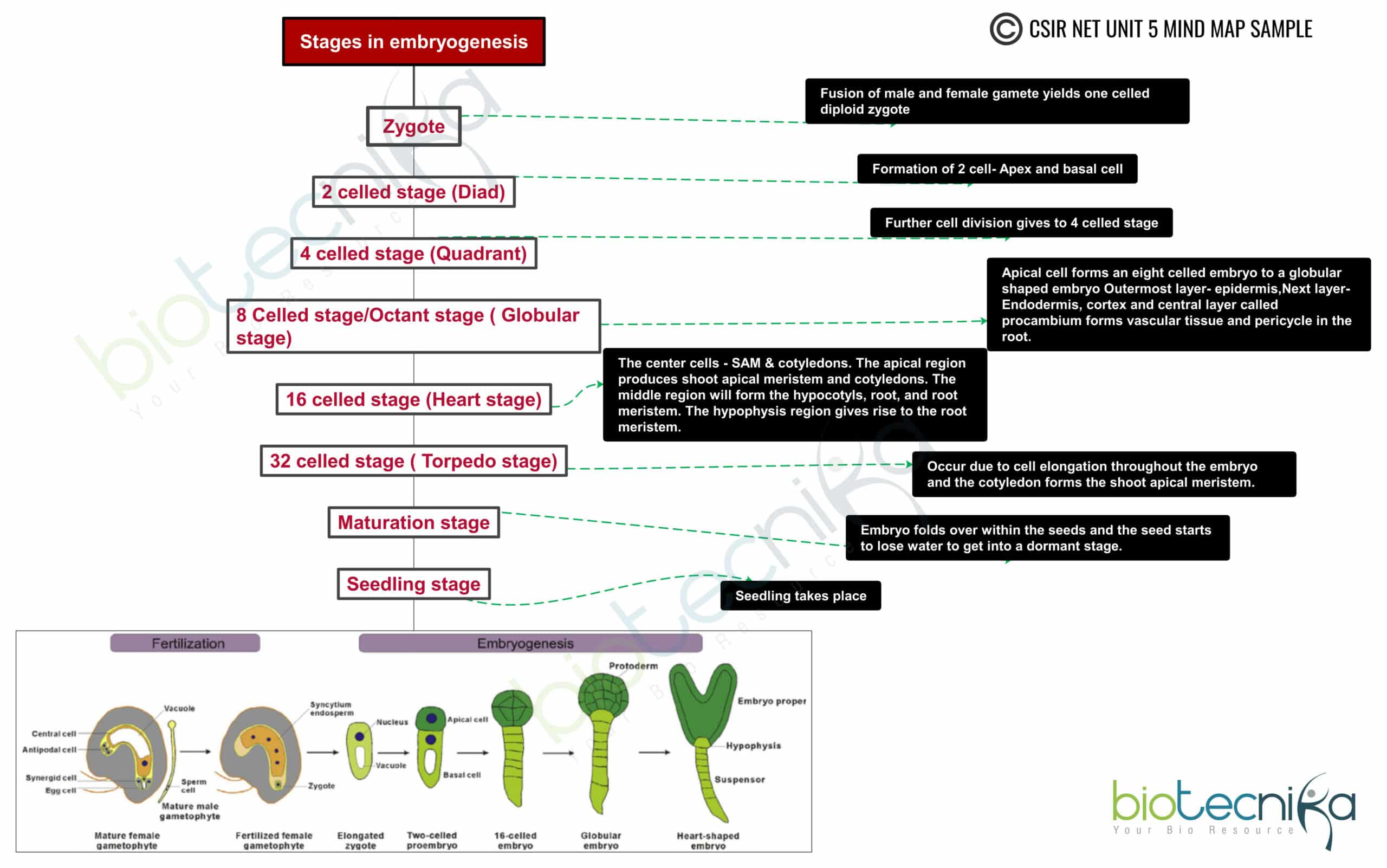














thank you for the information